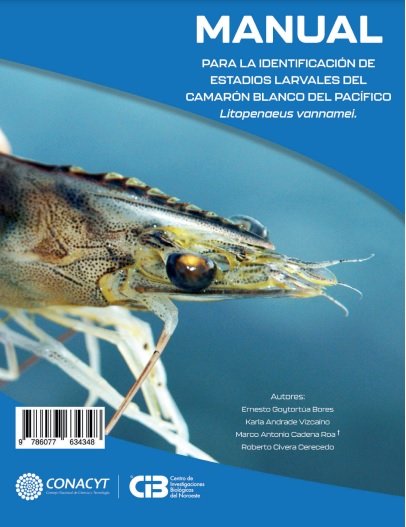
Aquaculture, both worldwide and in Mexico in particular, has experienced unprecedented growth in recent years, significantly contributing to the supply of aquatic food. However, as in any value chain, behind this success lies a crucial factor that often goes unnoticed: the larval stages of shrimp.
To ensure a consistent supply of high-quality shrimp larvae, it is essential to maintain a consistent production of postlarvae. The quality of the larvae is a critical factor for their survival and growth during the larval and postlarval stages.
The Aquaculture Nutrition Laboratory at the Biological Research Center of the Northwest, S.C., recognizes the importance of this task and takes pride in presenting its latest contribution to the aquaculture industry: the “Manual para la Identificación de Estadios Larvales del Camarón Blanco del Pacífico, Litopenaeus vannamei.”
This manual, the result of the findings obtained during the research project SEP-CONACYT No. 79047 “Evaluation of the ontogeny of digestive enzymes, histology of the digestive tract, and the biochemistry of early larvae and postlarvae of white shrimp Litopenaeus vannamei subjected to different feeding regimes,” aims to facilitate the timely recognition and identification of larval stages of Pacific White Shrimp Litopenaeus vannamei.
The Importance of Quality Postlarvae
The quality of postlarvae, the most advanced stage in the shrimp’s larval cycle, is a critical indicator of the physiological and health status of these organisms. This, in turn, is closely related to their survival and growth during their larval and postlarval stages.
In other words, to maintain a successful shrimp farming industry, it is essential to produce high-quality postlarvae.
However, producing high-quality postlarvae is not a simple task. It requires a deep understanding of the stages and developmental phases that shrimp go through until they reach the postlarval stage. Each molting process they undergo involves morphological and physiological changes, making identification an even greater challenge.
Additionally, an indispensable routine in a commercial shrimp postlarvae production laboratory is the identification of the stage and developmental phase of the organisms in production.
Stay Always Informed
Join our communities to instantly receive the most important news, reports, and analysis from the aquaculture industry.
Shrimp Larval Stages
Each of these stages is crucial for the success of producing high-quality postlarvae, as each molting process involves morphological and physiological changes that influence the survival and growth of the organisms. Furthermore, the type and size of food depend on the stage and developmental phase of the larvae.
The “Manual para la Identificación de Estadios Larvales del Camarón Blanco del Pacífico, Litopenaeus vannamei” provides a detailed and practical guide that will help aquaculture professionals accurately identify each stage and developmental phase of shrimp larvae.
The document provides detailed descriptions of the anatomical characteristics of the embryonic stage and larval stages: Nauplius Stage (Stages N-1 to N-5), Protozoa Stage (Stages Z-1 to Z-3), Mysis Stage (Stages M-1 to M-3), and postlarvae.
Conclusion
The Aquaculture Nutrition Laboratory at the Biological Research Center of the Northwest, S.C., is proud to make this valuable resource available to the aquaculture community and believes that its use will contribute to the growth and efficiency of the shrimp farming industry in Mexico.
The “Manual para la Identificación de Estadios Larvales del Camarón Blanco del Pacífico, Litopenaeus vannamei” is now available and can be obtained through the website of the Biological Research Center of the Northwest, S.C.
Reference (open access)
Ernesto Goytortúa Bores, Karla Andrade Vizcaíno, Marco Antonio Cadena Roa, Roberto Civera Cerecedo. 2023. MANUAL PARA LA IDENTIFICACIÓN DE ESTADIOS LARVALES DEL CAMARÓN BLANCO DEL PACÍFICO Litopenaeus vannamei. Centro de Investigaciones Biológicas del Noroeste, S.C CIBNOR. 54 p.
Editor at the digital magazine AquaHoy. He holds a degree in Aquaculture Biology from the National University of Santa (UNS) and a Master’s degree in Science and Innovation Management from the Polytechnic University of Valencia, with postgraduate diplomas in Business Innovation and Innovation Management. He possesses extensive experience in the aquaculture and fisheries sector, having led the Fisheries Innovation Unit of the National Program for Innovation in Fisheries and Aquaculture (PNIPA). He has served as a senior consultant in technology watch, an innovation project formulator and advisor, and a lecturer at UNS. He is a member of the Peruvian College of Biologists and was recognized by the World Aquaculture Society (WAS) in 2016 for his contribution to aquaculture.




